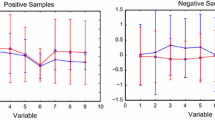Abstract
To improve the performance of classification algorithms, we proposed a new varianceconsidered machine (VCM) classification algorithm in a previous study. The study showed theoretically that VCMs have lower error probabilities than SVMs. The purpose of this paper is to experimentally demonstrate the superiority of VCMs. Therefore, we verified our proposal with several case experiments using data following a Gaussian distribution with different variances and prior probabilities. To estimate performance, the experiment for each case was executed 1000 times and the error rates were averaged for accuracy. The data of each experiment have different distances between means of data, and different ratios between training data and testing data. Thus, we proved that the error rate of VCMs is lower than the error rate of SVMs, although their performances were not similar in each case. Consequently, we expect that VCMs will be applied to a variety fields.
Similar content being viewed by others
References
R. A. Fisher, Sc. D., F. R. S., “The use of multiple measurements in taxonomic problems,” Reproduced from the Annals of Eugenics, vol. 7, pp. 179–188, 1936.
O. D. Richard, E. H. Peter, and G. S. David, Pattern Classification, 2nd ed., Wiley, New York, pp. 3–42, 2001.
H. K. Ekenel, J. Stallkamp, H. Gao, M. Fischer, and R. Stiefelhagen, “Face recognition for smart interactions,” Proc. of IEEE Int. Conf. Multimedia and Expo, vol. 2–5, pp. 1007–1010, 2007.
H. G. Yeom and K. B. Sim, “ERS and ERD analysis during the imaginary movement of arms,” Proc. of Int. Conf. Control, Automation and Systems, Seoul, Korea, pp. 2476–24802008, 2008.
C. Pan, Y. Fang, X. G. Yan, and C. X. Zheng, “Robust segmentation for low quality cell images from blood and bone marrow,” International Journal of Control, Automation, and Systems, vol. 4, no. 5, pp. 637–644, October 2006.
M. H. Song, J. Lee, S. P. Cho, K. J. Lee, and S. K. Yoo, “Support vector machine based arrhythmia classification using reduced features,” International Journal of Control, Automation, and Systems, vol. 3, no. 4, pp. 571–579, December 2005.
S. F. M. Assal, K. Watanabe, and K. Izumi, “Fuzzy hint acquisition for the collision avoidance solution of redundant manipulators using neural network,” International Journal of Control, Automation, and Systems, vol. 4, no. 1, pp. 17–29, February 2006.
V. N. Vapnik, “An overview of statistical learning theory,” IEEE Trans. Neural Networks, vol. 10, no. 5, pp. 988–999, Sep. 1999.
C. Cortes and V. Vapnik, “Support-vector networks,” Machine Learning, pp. 273–297, 1995.
B. Schoölkopf, K. K. Sung, C. J. C. Burges, F. Girosi, P. Niyogi, T. Poggio, and V. Vapnik, “Comparing support vector machines with Gaussian kernels to radial basis function classifiers,” IEEE Trans. Signal Process., vol. 45, no. 11, pp. 2758–2765, Nov. 1997.
P. W. Huang and C. H. Lee, “Automatic classification for pathological prostate images based on fraccase tal analysis,” IEEE Trans. Med. Imag., vol. 28, no. 7, pp. 1037–1050, July 2009.
H. K. Lee and S. J. Choi, “PCA+HMM+SVM for pattern classification,” Proc. of the 7th Int. Symp. Signal Process. and Its Applicant., Paris, France, vol. 1, pp. 541–544, July 1–4, 2003.
D. Boutte and B. Santhanam, “A hybrid ICA-SVM approach to continuous phase modulation recognition,” IEEE Signal Processing Letters, vol. 16, no. 5, pp. 402–405, May 2009
L. J. Cao and F. E. H. Tay, “Support vector machine with adaptive parameters in financial time series forecasting,” IEEE Trans. Neural Networks, vol. 14, no. 6, pp. 1506–1518, Nov. 2003.
H. G. Yeom, I. H. Jang, and K. B. Sim, “Variance considered machines: modification of optimal hyperplanes in support vector machines,” Proc. of IEEE Int. Symp. Industrial Electronics, Seoul, Korea, pp. 1144–1147, July 2009.
Author information
Authors and Affiliations
Corresponding author
Additional information
Recommended by Editor Young-Hoon Joo. This research was supported by the Chung-Ang University Scholarship Research Grants in 2010.
Hong-Gi Yeom received his B.S. and M.S. degrees in the School of Electrical and Electronics Engineering from Chung-Ang University in 2008 and 2010, respectively. His research interests include brain-computer interface, functional electrical stimulation, machine learning, wearable robot etc.
Seung-Min Park received his B.S. degree in the School of Electrical and Electronics Engineering from Chung-Ang University in 2010. He is currently in Master course in the School of Electrical and Electronics Engineering from Chung-Ang University, Korea. His research interests include brain-computer interface, intention recognition, pattern recognition, soft computing etc.
Junheong Park received his B.S. degree in the School of Electrical and Electronics Engineering from Chung-Ang University in 2011. He is currently in Master course in the School of Electrical and Electronics Engineering from Chung-Ang University, Korea. His research interests include brain-computer interface, image processing, pattern recognition etc.
Kwee-Bo Sim received his B.S. and M.S. degrees in the Department of Electronic Engineering from Chung-Ang University, Korea in 1984 and 1986 respectively, and his Ph.D. degree in the Department of Electrical Engineering from the University of Tokyo, Japan, in 1990. Since 1991, he has been a faculty member of the School of Electrical and Electronics Engineering at Chung-Ang University, where he is currently a Professor. His research interests are in artificial life, intelligent robot, intelligent system, multi-agent system, distributed autonomous robotic system, machine learning, adaptation algorithm, soft computing(neural network, fuzzy system, evolutionary computation), artificial immune systems, evolvable hardware, artificial brain, intelligent home, home networking, intelligent sensor, and ubiquitous computing etc. He is a member of IEEE, SICE, RSJ, IEICE, KITE, KIEE, KIIS, and ICROS Fellow.
Rights and permissions
About this article
Cite this article
Yeom, HG., Park, SM., Park, J. et al. Superiority demonstration of variance-considered machines by comparing error rate with support vector machines. Int. J. Control Autom. Syst. 9, 595–600 (2011). https://doi.org/10.1007/s12555-011-0321-1
Received:
Accepted:
Published:
Issue Date:
DOI: https://doi.org/10.1007/s12555-011-0321-1




